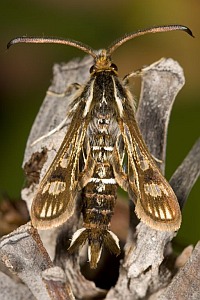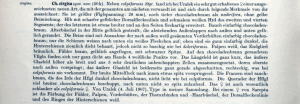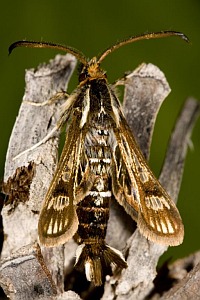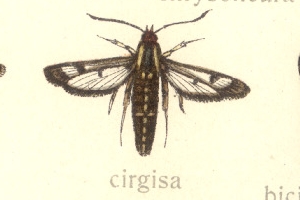2. Diagnose
2.1. Erstbeschreibung
3. Biologie
3.1. Nahrung der Raupe
- [Plumbaginaceae:] Limonium gmelini (Steppenschleier-Strandflieder)
- [Plumbaginaceae:] Limonium sp. (Strandflieder)
Bartsch et al. (2017: 51-52) vermerken: "This species occurs in salt steppes with stands of large Limonium species. The larvae feed in the upper part of the root. Development takes one year. In Central Anatolia we found adult larvae and pupae in a large, perennial Limonium that dries up after flowering. Only plants that had an inflorescence from the previous year were infested. The flight period is in June and July. Zukowsky (1915) states Limonium gmelini Kuntze as hostplant of P. cirgisa, but other species of Limonium constitute the hostplants of this species in Central Anatolia (Turkey) (pers. observation Lingenhöle, Bartsch). The habitats of this species, salt steppes and lakes, are critically endangered by grazing or drainage and conversion into arable land. Therefore, this species is of considerable conservation value."
4. Weitere Informationen
4.1. Andere Schreibweisen
- Pyropteron cirgisum [nach dem Agreement in gender korrekte Schreibweise (Gender Agreement des ICZN)]
4.2. Andere Kombinationen
- Chamaesphecia cirgisa Bartel, 1912 [Originalkombination]
- Synansphecia cirgisa (Bartel, 1912)
4.3. Synonyme
- Chamaesphecia montandoni Le Cerf, 1922
4.4. Faunistik
Locus typicus ist "Uralsk", wobei mir nicht ganz klar ist, welches "Uralsk" hier gemeint war. Das Vorkommen in Europa ist auf die Ukraine und den Süden und Osten des europäischen Teils von Russland beschränkt, wozu noch eine zweifelhafte Angabe aus Rumänien kommt. Bartsch et al. (2021: 52) erläutern: "Very local in south-eastern Europe (south-western Russia, Ukraine) and south-western Asia (Turkey, western Kazachstan) (Laštůvka & Laštůvka 1995, 2001, Špatenka et al. 1999, Garrevoet et al. 2007). An old record from Romania is questionable. Špatenka et al. (1999) also report this species from Iran; however, Kallies & Špatenka (2003) did not find evidence for the presence of this species in this country."
(Autor: Erwin Rennwald)
4.5. Literatur
- Erstbeschreibung: Bartel, M. (1912): 25. Familie: Aegeriidae (Sesiidae). — In: Seitz, A. (Hrsg.) (1909-1914). Die Gross-Schmetterlinge der Erde 2: I-VII, 1-479, pl. 1-56 [hier: 375-416]. Stuttgart (Fritz Lehmann).
- Bartsch, D., Pühringer, F., Milla, L., Lingenhöle, A. & A. Kallies (2021): A molecular phylogeny and revision of the genus Pyropteron Newman, 1832 (Lepidoptera, Sesiidae) reveals unexpected diversity and frequent hostplant switch as a driver of speciation. — Zootaxa 4972: 1-75.
- Spatenka, K. & Z. Laštůvka (1988): Typen der Glasflügler aus der Staudinger- und Püngeler Sammlung im Zoologischen Museum Berlin (Lepidoptera, Sesiidae). — Deutsche Entomologische Zeitschrift, Neue Folge 35 (4-5): 331-339 [Digitalisat und PDF-Download auf onlinelibrary.wiley.com].




![Vorkommen in Russland (europäischer Teil bis Manytsch-Niederung) [Sinev (2021)]](/res/img/flag/ru.gif)
![Vorkommen im europäischen Teil von Kasachstan [Locus typicus Uralsk]](/res/img/flag/kz.gif)

![Vorkommen auf der Krim [Sinev (2021)]](/res/img/flag/ua-kri.gif)
![Vorkommen in Rumänien [Rákosy L. & M. Goia (2021): Lepidopterle din România: lista sistematică şi distribuţie]](/res/img/flag/ro.gif)
![Vorkommen im asiatischen Teil der Türkei [Koçak & Kemal (2018) als Synansphecia cirgisa]](/res/img/flag/tr.gif)




